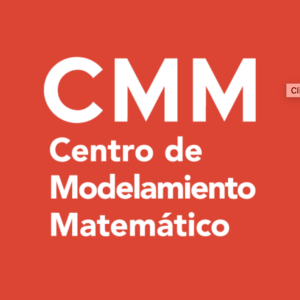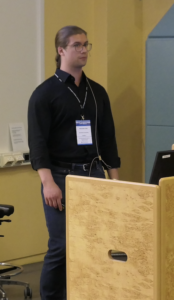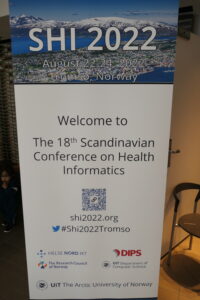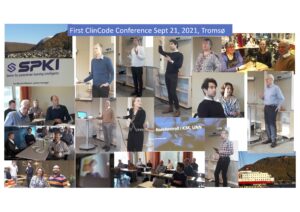Congratulations for the Phd stipend from the PhD Visiting Program 2023 from Center for Mathematical Modeling (CMM) at the University of Chile, (Universidad de Chile) in Santiago, Chile. This will make it possible for Thomas Vakili to visit the center during three months the fall of 2023 and work with privacy preserving methods for Chilean patient records jointly with Dr. Jocelyn Dunstan that invited Thomas.
Master thesis presentation at SHI 2022, Tromsø
Alexander Dolk presented his and Hjalmar Davidsen master thesis in form of a scientific paper with the title Evaluation of LIME and SHAP in Explaining Automatic ICD-10 Classifications of Swedish Gastrointestinal Discharge Summaries at the 18th Scandinavian Conference on Health Informatics, SHI 2022, 22-23 Aug, 2022 i Tromsø, Norway, both supervisor Thomas Vakili and I were also part of the paper.
The research work were part of the ClinCode project in Tromsø. At the conference another paper also from the ClinCode project was presented with title The Influence of NegEx on ICD-10 Code Prediction in Swedish: How is the Performance of BERT and SVM Models Affected by Negations? by Andrius Budrionis, Taridzo Chomutare, Therese Olsen Svenning and Hercules Dalianis.
There is a conference report from SHI 2022 available upon request to Hercules.
LREC 2022 in Marseille, France
The 13th Language Resources and Evaluation Conference (LREC 2022) was held in Marseille, France with over 1000 participants. Four of us from DSV were there to present our recent findings and learn about the state of the NLP field. Anastasios Lamproudis, Aron Henriksson, Hercules Dalianis and I (Thomas Vakili) had a total of four papers for the conference and its workshops.
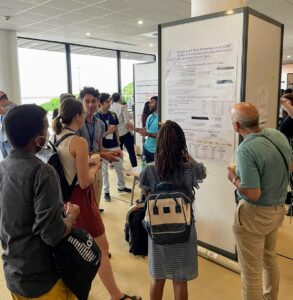 All four of us presented a paper about continued pre-training BERT models using automatically de-identified clinical data. We showed that pre-training with safer de-identified clinical data works just as well as using sensitive data. During the conference, we also received ethical approval to share one of the models with academic researchers.
All four of us presented a paper about continued pre-training BERT models using automatically de-identified clinical data. We showed that pre-training with safer de-identified clinical data works just as well as using sensitive data. During the conference, we also received ethical approval to share one of the models with academic researchers.
I also presented two workshop papers co-written with researchers from Linköping University, Linköping University Hospital and RISE. The first paper was about using a clinical BERT model to conduct terminology extraction to find terms associated with medical implants in electronic health records. The other paper investigated how well the de-identification system developed at DSV using the Health Bank performs on data from clinics not present in our datasets.
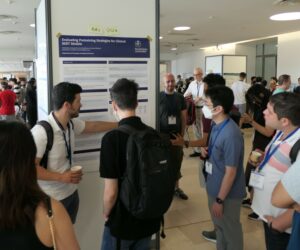 Anastasios, Aron and Hercules presented a paper in which they evaluated various strategies for creating clinical BERT models. They compared initializing the model from a general-domain model versus pre-training from scratch, and whether adapting the general-domain vocabulary to the clinical domain helps or not. They found that all strategies lead to improvements on clinical tasks, but that all strategies ultimately lead to similarly performing models. However, initializing from a general-domain model decreased the amount of training needed.
Anastasios, Aron and Hercules presented a paper in which they evaluated various strategies for creating clinical BERT models. They compared initializing the model from a general-domain model versus pre-training from scratch, and whether adapting the general-domain vocabulary to the clinical domain helps or not. They found that all strategies lead to improvements on clinical tasks, but that all strategies ultimately lead to similarly performing models. However, initializing from a general-domain model decreased the amount of training needed.
We had many fruitful discussions and returned home full of ideas to try out. If you are interested in seeing our posters, then you can find them here and here.
Paper at ACL 2022 workshop: BioNLP
 I had the pleasure of presenting a poster of a paper by Hercules Dalianis and me: Utility Preservation of Clinical Text After De-Identification. The paper investigates how automatic de-identification, a necessarily imperfect process, impacts the quality of the resulting texts. When a de-identification system incorrectly class a word as sensitive, the data will be slightly corrupted. Many researchers have been worried that this would make the data less useful, and we investigate this issue.
I had the pleasure of presenting a poster of a paper by Hercules Dalianis and me: Utility Preservation of Clinical Text After De-Identification. The paper investigates how automatic de-identification, a necessarily imperfect process, impacts the quality of the resulting texts. When a de-identification system incorrectly class a word as sensitive, the data will be slightly corrupted. Many researchers have been worried that this would make the data less useful, and we investigate this issue.
The impact of automatic de-identification on quality is evaluated using both qualitative and quantitative (machine learning) methods. We find no losses in utility for clinical NLP on three downstream clinical tasks. In fact, the machine learning models trained using automatic de-identification seem to work just as well as those trained using sensitive data. We also find that the experts in our study think the de-identification works well.
Participating in the 60th ACL conference was a great experience. I learned a lot from our global NLP community and met many researchers interested in our work at DSV. You can find the paper here, and the poster I presented here.
LREC 2022 – Accepted papers
Hello everyone!
We have two new papers accepted to the 13th Language Resources and Evaluation Conference, LREC 2022 that takes place in Marseille the upcoming June!
The first paper is authored by Thomas Vakili, Aron Henriksson, Hercules Dalianis, and me and is called “Downstream Task Performance of BERT Models Pre-Trained Using Automatically De-Identified Clinical Data” with code 412. It evaluates the performance of a language model that is trained using De-identified clinical text in later tasks, and explores the de-identification impact in the development of the language model.
The second paper is authored by Aron Henriksson, Hercules Dalianis, and me and is called “Evaluating Pre-training Strategies for Clinical BERT Models” with code 661. It empirically compares different pre-training strategies for the development of domain-adapted language models in the Swedish clinical text domain.
You can find all the accepted papers including the ones mentioned above here!
AAAI Fall Symposium and EMNLP – November 2021
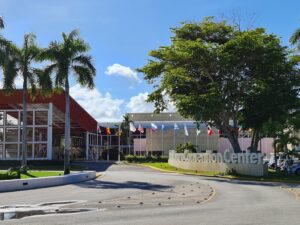 Professor Hercules Dalianis and I got a paper about the privacy preserving qualities of BERT accepted to the AAAI Fall Symposium on Human Partnership with Medical Artificial Intelligence! The paper is titled Are Clinical BERT Models Privacy Preserving? The Difficulty of Extracting Patient-Condition Associations. Our results strongly suggest that BERT’s poor generative capabilities makes it resistant to training data extraction attacks. Other models, such as GPT-2, have been shown to be susceptible to these attacks. From a privacy perspective, being a poor generator may be a feature!
Professor Hercules Dalianis and I got a paper about the privacy preserving qualities of BERT accepted to the AAAI Fall Symposium on Human Partnership with Medical Artificial Intelligence! The paper is titled Are Clinical BERT Models Privacy Preserving? The Difficulty of Extracting Patient-Condition Associations. Our results strongly suggest that BERT’s poor generative capabilities makes it resistant to training data extraction attacks. Other models, such as GPT-2, have been shown to be susceptible to these attacks. From a privacy perspective, being a poor generator may be a feature!
Later in the same week, I flew from Stockholm to Punta Cana in the Dominican Republic to participate at EMNLP 2021. Almost 500 participants were there, with the total number of participants exceeding 4,000. There were many interesting presentations regarding NLP in general, but also some that were specifically about the privacy aspects of NLP. It was a great experience to learn where the field is headed and also to get to know many talented researchers. I have written a summary of some of the interesting papers – reach out if you are interested in it.
DSV at the First ClinCode Conference in Tromsø, Norway
Professor Hercules Dalianis, Sonja Remmer and myself represented DSV at the First ClinCode Conference. The conference gathered experts in medicine and computer science from across the Nordics and took place at the University Hospital of North Norway (UNN) in Tromsø.
The conference was chaired by Hercules, who is also a guest professor at the Norwegian Centre for E-health Research. Sonja shared her work on automatic ICD-10 classification using BERT and I spoke about the difficulty of extracting training data from clinical BERT models.
Several participants had an industry or medical background. This provided valuable insights into how our research at DSV may be used in practice and what challenges are most important. It also highlighted the great potential that can be unlocked by continuing to investigate ICD-10 classification and other medical NLP problems.
Many excellent ideas were hatched in the discussions, and it was lovely to visit the beautiful polar city of Tromsø. Personally, I really look forward to future iterations of the conference!
Three papers accepted to the International Conference Recent Advances in Natural Language Processing, RANLP 2021, September 1-3, 2021, Bulgaria.
Three papers accepted to the International Conference Recent Advances in Natural Language Processing, RANLP 2021, September 1-3, 2021 in Varna, Bulgaria,
from the Clinical Text Mining group at DSV:
Sonja Remmer, Anastasios Lamproudis and Hercules Dalianis.
Multi-label Diagnosis Classification of Swedish Discharge Summaries – ICD-10 Code Assignment Using KB-BERT.
Alberto Blanco, Sonja Remmer, Alicia Pérez, Hercules Dalianis and Arantza Casillas.
On the contribution of per-ICD attention mechanisms to classify health records in languages with fewer resources than English.
Anastasios Lamproudis, Aron Henriksson and Hercules Dalianis.
Developing a Clinical Language Model for Swedish: Continued Pretraining of Generic BERT with In-Domain Data.
The first paper in collaboration with the Norwegian Centre for E-health Research in Tromsø. Norway and the second paper also with the HiTZ Center – Ixa, University of the Basque Country UPV/EHU, Donostia, Spain.
The two first papers study how to automatically assign ICD-10 diagnosis codes to a discharge summary, for Swedish and for Spanish a respectively. Usually this time consuming work is carried out manually by a physician or a coder.We use machine learning and specifically Deep AI Learning to perform this and already manually assign codes to discharges summaries.
In the third paper is constructed a clinical deep learning BERT model for Swedish that performs much better than a regular non-clinical model for clinical down stream tasks as for example automatic ICD-10 diagnosis coding.
